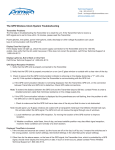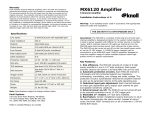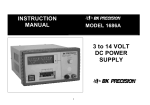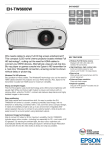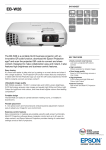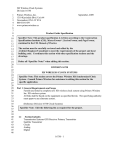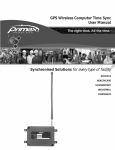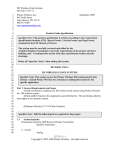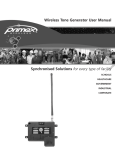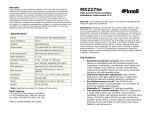Download 16730-1 SECTION 16730 GPS WIRELESS
Transcript
SECTION 16730 GPS WIRELESS CLOCK SYSTEMS PART 1 - GENERAL 1.1 SUMMARY A. 1.2 Section Includes A. B. C. D. 1.3 1.5 Satellite Transmitter Wireless Receiver Clocks, Analog Power Supplies References A. 1.4 Furnish and install new GPS wireless clocks and equipment necessary to extend the existing school system into the new building. The existing system is Primex Wireless Inc. GPS wireless system. This Technical Specification and Associated Drawings Primex Wireless GPS Satellite Time System User Manual. Definitions A. GPS: Global Positioning System, a worldwide system that employs 24 satellites in an integrated network to determine geographic location anywhere in the world, and which employs and transmits Universal Coordinated Time, the world’s most accurate and reliable time. B. UTC: Universal Coordinated Time System Description A. GPS wireless clock system shall continually synchronize clocks throughout the facility, and shall be capable of clock readouts in multiple time zones where desired. B. The system shall provide wireless time using GPS and be synchronized to UTC. The system shall not require hard wiring. Clocks shall automatically adjust for Daylight Saving Time C. Analog Clocks shall be synchronized to within 10 milliseconds 6 times per day, and the system shall have an internal oscillator that maintains plus or minus one second per day between synchronizations, so that clock accuracy shall not exceed plus or minus 0.2 seconds. D. The system shall include an internal clock reference so that failure of the GPS signal shall not cause the clocks to fail in indicating time. E. The system shall incorporate a “fail-safe” design so that failure of any component shall not cause failure of the system. Upon restoration of power or repair of failed component, the system shall resume normal Operation without the need to reset the system or any component thereof. 16730-1 1.6 1.7 1.8 F. Clock locations shall be as indicated, and clocks shall be fully portable, capable of being relocated at any time. G. The system must operate in accordance with a “Radio Station Authorization”, Form FCC 601 – LM, granted by the Federal Communications Commission (FCC). This license will be issued to and held by the end user. Regulatory Requirements A. Equipment and components furnished shall be of manufacturer’s latest model. B. The end user will hold a license, known as a “Radio Station Authorization” granted by the FCC. C. This license grants the end user protected use for wireless transmission at the designated frequency. D. This license will designate a unique “call sign” for each end user. E. Transmitter and receiver shall comply with Part 90 of FCC rules as follows: F. This device may not cause harmful interference, and This device must accept interference received, including interference that may cause undesired operation. G. Transmitter frequency shall be governed by FCC Part 90.35. H. Transmitter output power shall be governed by FCC Part 90 257 (b) I. System shall be installed in compliance with local and state authorities having jurisdiction. Submittals A. Product Data: Submit complete catalog data for each component, describing physical characteristics and method of installation. Submit brochure showing available colors and finishes of clocks. B. Operating License: Submit evidence of application for FCC Radio Station Authorization prior to installing equipment. Furnish the license or a copy of the application for the license, to the Owner/End User prior to operating the equipment. The original license must be delivered to the Owner/End User. C. Manufacturer's Instructions: Submit complete installation, set-up and instructions. maintenance Substitutions A. Proposed substitutions, to be considered, shall be manufactured of equivalent materials that meet or exceed specified requirements of this Section. B. Proposed substitutions shall be identified not less than 10 days prior to bid date. C. Other systems requiring wiring and/or conduit between master and clocks will not be accepted. D. Other systems using wireless technology in an unlicensed frequency range will not be accepted. 16730-2 E. 1.9 1.10 1.11 1.12 Quality Assurance A. Permits: Obtain operating license for the transmitter from the FCC. B. Manufacturer: Company specializing in manufacturing commercial time system products with a minimum of 30 continuous years of documented experience including 4 years experience producing GPS wireless time systems. C. Installer: Company with documented experience in the installation of commercial time systems. D. Prior to installation, a site survey must be performed to determine proper transmitter placement. Delivery Storage and Handling A. Deliver all components to the site in the manufacturer's original packaging. Packaging shall contain manufacturer's name and address, product identification number, and other related information. B. Store equipment in finished building, unopened containers until ready for installation. Project Site Conditions A. Clocks shall not be installed until painting and other finish work in each room is complete. B. Coordinate installation of GPS receiver for access to the roof or exterior side wall so that the bracket and related fasteners are watertight. System Startup A. 1.13 Other systems using wireless technology where the license is held by any party other than the end user will not be accepted. At completion of installation and prior to final acceptance, turn on the equipment; ensure that all equipment is operating properly, and that all clocks are functioning. Warranty A. Manufacturer will provide a 1 year warranty on GPS receiver, transmitter, and satellite transmitter. All other components will have a 1 year warranty. PART 2 - Products 2.1 Manufacturer A. 2.2 GPS wireless clock system shall be manufactured by Primex Wireless, Inc., N3211 County Road H, Lake Geneva WI 53147 (800) 537-0464 FAX (262) 248-0061 www.primexwireless.com. Sequence of Operation A. Transmitter Operation: When power is first applied to the transmitter, it checks for and displays the software version. It then checks the position of the switches and stores their position in memory. The transmitter looks for the GPS time signal. Once the transmitter has received the GPS time, it sets its internal clock to that time. The transmitter then 16730-3 starts to transmit its internal time once every second. The transmitter updates its internal clock every time it receives valid time data from the GPS. 2.3 B. Analog Clock Operation: Apply power or insert batteries. Follow set up procedures detailed in manufacturer’s instructions. C. After initial setup, the clock will shut off the receiver. Six times each day, the microprocessor will activate the receiver and starting with the stored channel, it will again look for a valid time signal. If necessary, the clocks will resynchronize to the correct time. D. If the clock has not decoded a valid time signal for a pre-determined number of days, it will go to a step mode. Non signal reception can be caused by low battery voltage. If this occurs, replace the batteries. Equipment A. General: The clock system shall include a satellite transmitter, a wireless receiver, indicating clocks, and all accessories for complete operation. B. Wireless Receiver Switches: Switches shall receive time packets from the Primary Transmitter and relay the synchronized time to the Satellite Transmitter connected to it. The unit shall include the following: 1. Antenna mounted on top of the switch housing, 11-1/2 inches (292mm) long. 2. Power Supply: Input 120 VAC 50/60 Hz, 0.4 amps Output: 9 volt DC, 1.5 amps 3. RS 232 data cable, 5 feet (1.5mm) long 4. Daylight Savings Time bypass switch 5. Dimensions: 4-1/4 inches (108mm) long, 5/-3/4 inches (146mm) wide, 1-1/4 inches (31.75mm) deep. 6. Weight: 12 ounces (.34kg) 7. Operating Range: 32 degrees F to 158 degrees F (0 to 70 degrees C) C. Satellite Transmitters Primex Wireless Model 14401: Satellite Transmitters shall receive the signal from the Wireless Receiver Switches and transmit the signal to the devices in its vicinity, which are out of the range from the Master Transmitter. The unit shall include the following: 1. Antenna mounted on top of the housing, 46 inches (1168mm) long. 2. Wireless Receiver Switch. 3. Power Supply Input: 120 VAC, 50/60 Hz, 0.4 amps Output: 9 volt DC, 1.5 amps. 4. 6 foot (1.83m) cord 5. Surge Suppressor/Battery Backup 6. Mounting Shelf. 7. Transmission Power: 1 watt maximum 8. 72 MHz frequency. D. Traditional analog clocks (battery): Analog clocks shall be wall mounted. Clocks shall have polycarbonate frame and polycarbonate lens. Face shall be white. Hour and minute hands shall be black. 1. 12-1/2 inch (317.5mm) diameter analog clock: Primex Wireless Model 14155 2. 16 inch (406.4mm) diameter analog clock: Primex Wireless Model 14163 3. Analog clocks shall be battery-operated, 4. Analog clocks shall be capable of automatically adjusting for Daylight Saving Time. An on-off switch located on the transmitter shall disable this function If desired. 5. Time shall be automatically updated from the transmitter 6 times per day. 6. Analog clocks shall remember the time during changing of batteries. 7. 12.5 inch (317.5mm) analog clocks shall have a tamper proof/theft resistant clock lock mounting slots. 16730-4 8. 9. E. Analog clock receivers shall be as follows: a) Receiver sensitivity: >-110 dBm b) Receiver power: dual lithium battery pack, supplied by manufacturer. c) Antenna type: internal d) Antenna gain: -7 dBd If the transmitter stops transmitting valid time signals due to power failure, the clocks will continue to function as accurate quartz clocks until a valid time signal is decoded. If signal transmission is not restored after 96 hours, the second hand will “five step” as a visual indicator that the signal has been lost. Should the clocks lose power and signal, the clocks will not function. Dual D Lithium Battery Pack Primex Wireless Model 14885 contains two sealed parallel lithium primary batteries. PART 3 – Execution 3.1 3.2 3.3 Examination A. Verify that construction is complete in spaces to receive equipment and that rooms are clean and dry. B. Verify that 120 volt electrical outlet is located within 6 feet (1.83m) of location of transmitter and the outlet is operational and properly grounded. Installation A. Provide all equipment necessary for a complete and operable system. B. Satellite Transmitter:Locate transmitter where indicated, a minimum of 6 to 8 feet above the floor, away from large metal objects such as filing cabinets, lockers or metal framed walls. Transmitter(s) will be placed at locations indicated on plans. C. Attach receiver to transmitter using cable. D. Connect antenna to transmitter, using care not to strip threads. E. Connect power supply to the transmitter. F. Set the channel number on the display to correspond to the FCC license. G. Plug power supply into electrical outlet. H. Analog clocks perform the following operations with each clock: 1. Set clock to correct time in accordance with manufacturer's instructions. 2. Observe analog clock until valid signals are received and analog clock adjusts itself to correct time. 3. Install the analog clock on the wall in the indicated location, plumb, level and tight against the wall. If using 12-1/2 inch (317.5mm) clock, attach using clock-lock hanging method and suitable fasteners as approved by clock manufacturer. Adjusting A. 3.4 Prior to final acceptance, inspect each clock, adjust as required, and replace parts which are found defective. Cleaning 16730-5 A. 3.5 Demonstration A. 3.6 Provide training to Owner's representative on setting and adjusting clocks, replacing batteries and routine maintenance. Protection A. 3.7 Prior to final acceptance, clean exposed surfaces of clocks, using cleaning methods recommended by clock manufacturer. Remove temporary labels from clock faces. Do not remove labels from backs of clocks. Protect finished installation until final acceptance of the project. Testing A. All devices must be tested at their operational location under normal operational conditions to assure reception of signal. END OF SECTION 16730-6







